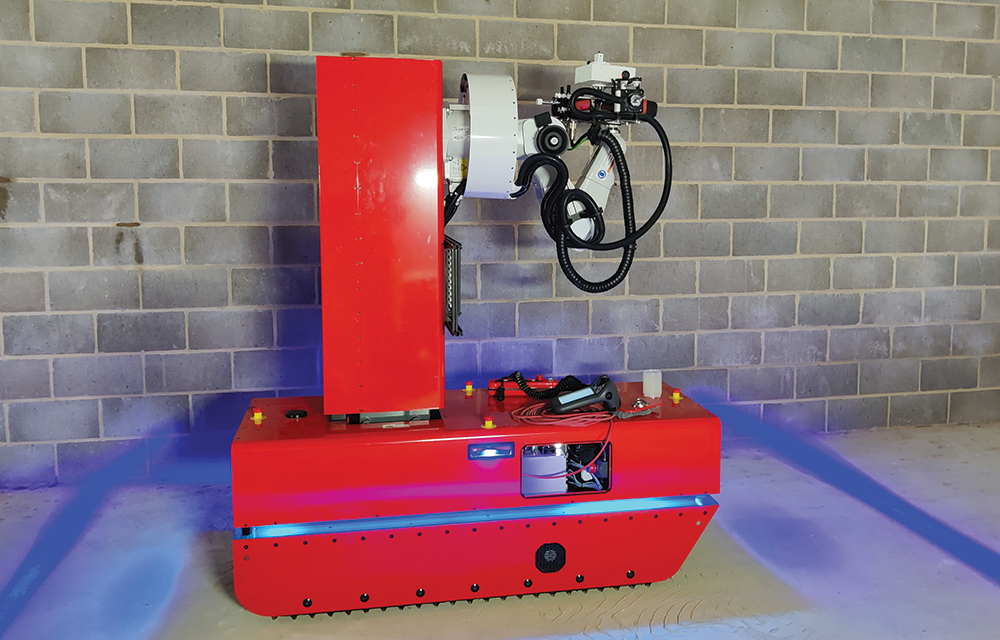
Academia Spotlight: Ruth Dowsett, a lecture in virtual and digital construction explains how she and her colleagues at the University of Reading are working to understand the implications of introducing robots into the construction supply chain.
Tell us about the research you are currently working on.
I have been working on a Transforming Network Plus funded project, called: ‘Feasible Future Scenarios – SME robotic adoption’ – with my colleagues at the University of Reading. The project aims to understand the implications of introducing robotics into the construction supply chain. We have been using a foresight approach to explore how robotics and machine-based automation may play out in different characterisations of the industry, from the perspective of SMEs.
Foresight has been used by the sector before to think about what the future of construction will look like. But quite often it starts and stops at technological predictions, which are sometimes overly optimistic. This gets the industry only so far because these predictions don’t really tell us much about the extent of change for those working at the coalface. And so, our argument is that we need a way to draw out complex organisational stories of implementation as we explore the future to help inform decision-makers and turn technological promise into substantive change.
In our foresight approach we do this by focusing innovation efforts on non-technological development such as supply chain configurations, trading relationships and business models, and by giving primacy to SME manufacturers in the scenario development process because these are the people who have often been discounted in construction foresight efforts in the past and for whom robotics is a seemingly ‘low-hanging fruit’ for automation.
What inspired you to pick this topic?
I first became involved in the topic area when I worked as a research associate on the Skanska-led, Innovation UK-funded FRAMBE (Flexible Robotic Assembly Modules for the Built Environment) project exploring the challenges of developing and implementing multi-task robotic systems in mobile factory scenarios. The FRAMBE project highlighted significant hurdles facing the roll out of robotics in the construction sector that formed the catalyst for the ‘Feasible Futures’ project. For example, a key question surrounding the industrialisation of robotics is who will own the robotic system since contractor business models tend to rely on subcontracting plant equipment. Similarly, a key constraint for SMEs is lack of employment space to experiment with different robotic system set-ups. These questions and challenges provide considerable opportunity to develop new ways of working to address them and transform the industry.
What’s the problem/issue?
Robotics and automation have the potential to transform the sector through improvements to productivity, efficiency and safety. Yet barriers such as the inflexibility of coping with product variation, lack of standardised processes and high implementation costs have slowed the adoption of robotics in construction, particularly among SMEs. There is also a tendency to focus innovation efforts at the scale of the Tier 1 contractor and on technological development alone (e.g. onsite robotics and flexible manufacturing). If robotics and automation really are set to transform the industry, we need to look at the multiple and intersecting levels of impact these technologies will have, and we suggest that industry understanding of these impacts could be expanded by downgrading the primacy of technology and focusing foresight activities further along the supply chain at the value proposition of automating manufacturing processes for SMEs.
How do you see your work helping?
The project as whole enables SME firms – in collaboration with their peers – to create alternative futures of the construction industry in which robotics and automation are a mainstay. The ‘Feasible Futures’ approach helps by introducing SMEs to the challenges and opportunities for robotics and automation thereby prompting an increase in awareness of the benefits of adopting robotics and automation, and helping them to consider transition pathways that can accelerate automated manufacturing within the supply chains they operate in.
Thinking about the different ways the construction industry could operate with manufacturing robotics as a mainstay could provide significant insight into which characteristics of the industry need to change (and in some instances perhaps radically) to enable the uptake of robotics. A foresight approach to explore these characteristics in potential futures, the interconnectivities between them and their impacts, that’s designed to provoke creative solutions, will be important in making the potentially radical transition to an automated construction supply chain. By imagining the future and then trying to link it back to the present, potential paths of transformation can be considered and plans for actions developed.
Who is it aimed at in the industry?
In this project, whilst we were specifically looking at the impact of robotics from the perspective of SMEs, to understand the impacts at multiple and intersecting levels we also require insight from those elsewhere in the supply chain e.g. contractors, software vendors, and industry bodies. Throughout the duration of the research participants were interviewed and attended workshops to co-create future scenarios of the sector placing a stakeholder at the centre of each scenario. Participants explored, contested, and extended four scenarios. These were: ‘Tier 1 Oligopolies’, ‘Software Vendor and OEM domination’, ‘SME robotic cooperatives’, and ‘Government Expropriation’. Scenario development was carried out with a view to create a strong knowledge base of the challenges and constraints SMEs could potentially face in these futures, and to also help create potential pathways that attend to the identified challenges and constraints. The ‘Feasible Futures’ method developed is aimed to help facilitate the exploration of value propositions for adoption, understood from the perspective of the SME in relation to the broader industrial landscape, having a positive impact on investment into robotics and automation.
Perhaps most significantly, the approach provided an arena in which businesses – who would not normally come together to discuss such things – could reflect on and share their organisational experience. It is a foresight approach very much centred around reciprocal knowledge exchange and the co-construction of “good” stories of implementation.
Where do you go from here?
To identify the impact and commercial potential of the ‘Feasible Future Scenarios – SME robotic adoption’ approach, the research team, funded by the Transforming Construction Network Plus Impact programme took part in the ICURe accelerator programme. During the accelerator programme we recast the ‘Feasible Futures’ concept as a business method consisting of tiered packages of foresight facilitation delivered through second-tier consultancy (e.g. industry bodies and training providers). The next steps are to roll this out gathering further datasets around industry perspectives on the implications of robotics and strategic pathways for adoption and implementation. These datasets will inform future research in the space of construction foresight to ask the following questions: How might SMEs use these scenarios to make decisions around changes to operational activities? How might the wider sector respond in light of stories of implementation created from scenario development? What are the varying implications to the broader built environment if certain stakeholders prevail over others? What direction do we want to move in? How do we get there?
Ruth Dowsett is lecturer in virtual and digital construction at the University of Reading.











